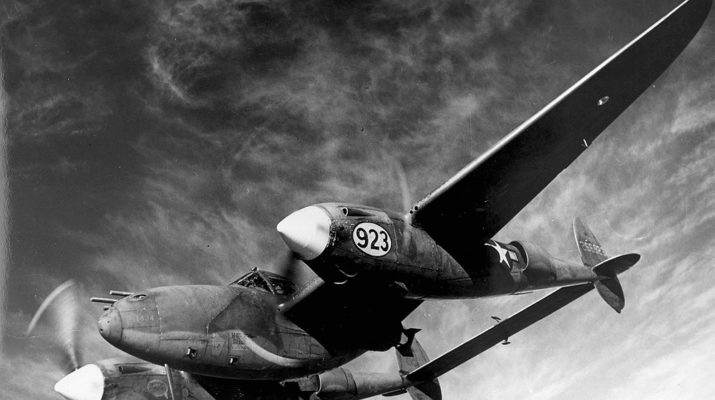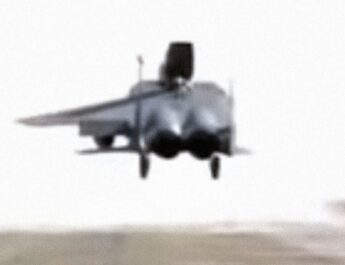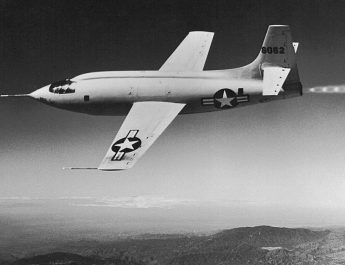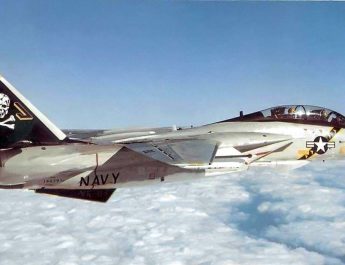Of all the US fighters of World War Two only one continued in production throughout the entire conflict. This was Lockheed P-38 Lightning. Because of its firepower its speed and the reliability of its twin engines, this versatile advanced design proved one of America’s most durable and valuable investments in 1933.
The recently restructured Lockheed Aircraft Company was having to gamble its future on the production of an advanced twin-engine aircraft but, it hopes would stay abreast of aviation technology for the next 10 years to prove their new design.
A scale model was produced at the then incredibly expensive price, of five thousand dollars, and shipped to the University of Michigan for Wind tunnel testing. During the course of this exercise Lockheed’s executives met a young engineer by the name of Kelly Johnson. Johnson’s foresight on aircraft designs so impressed Lockheed that he was promptly offered a position and was placed on the company’s payroll.
This was to be the beginning of a brilliant association. The benefits of which would see Lockheed rise to become one of the most successful aviation companies in the world.
In 1933 the new project meant taking an awful gamble in very uncertain time. Perhaps Lockheed x’ biggest asset against failure lay within the human resource of its skilled staff. Although the company was becoming highly automated, this was still the period where technicians considered themselves craftsmen and Lockheed’s production teams were very much from the old school with an exacting pride in their work. They also knew that the company’s future hinged upon the outcome of this new multi-purpose twin engined aircraft.
To some extent world politics favored the company. The rise of the Axis powers, particularly Germany’s rearmament demonstrated a developing threat to world peace and emphasized the need for expansion of American airpower. Soon, the American Defense Department identified the need for a high-speed anti bomber aircraft, but they set the specifications so high that few in the industry thought they could be attained.
Lockheed gave the project to Kelly Johnson, who believed that the required maximum speed of 360 miles per hour could actually be achieved, but only by using an aircraft with the power of two engines. In fact Johnson’s design was capable of over 400 miles an hour.
The twin engined formula would ordinarily result in an aircraft which had very little maneuverability. But to counter this, Johnson developed a brilliant twin boom concept which won a Defense Department contract in June 1937, to produce just one aircraft, the model 22, at a fixed contract price of 163.000 dollars.
Again, Lockheed was in the business of taking risks. The prototype was to actually cost five times that amount. Yet for the company the extra expense was ultimately to be one of the best investments they had ever made.
The model 22 was then given the official fighter designation P-38. With Europe on the verge of war production of the new aircraft was still very secret. By January 1939 the new aircraft was ready for its first flight. After minor modifications were at first required on the braking system, on the 27th the first XP-38, the forerunner of almost 10,000 fighters, took to the air for the first time.
The obtaining of government funds for armaments was still politically sensitive and the Army Air Force now considered the need for public support for the P-38.
To do this, it lifted the covers off the project by announcing an attempt to break the Transamerica air speed record. Thus on February 11th, 1939 the only P-38 then built which had only six hours flying time on the clock, began its record-breaking flight with lieutenant Ben Kelsey at the controls and the American taxpayer looking on to cover the distance.
It was necessary for Kelsey to refuel at Amarillo airfield before his final destination at Mitchell field. These fuel stops would have added an extra hour to the aircraft’s overall flying time, which nevertheless still achieved the 2490 miles required, in just seven hours and 43 minutes.
Only marginally longer than Howard Hughes earlier flight in a specially designed aircraft which carried enough fuel for the entire trip. Unfortunately that kills his last approach to Mitchell field the aircraft hit a line of trees, crashed and was destroyed.
Nevertheless, the speed of the plane was so impressive that the Defense Department instantly gave Lockheed a contract for 13 YP-38. The aircraft were to have a single 37 millimeter cannon plus four machine guns, two 30cal and two 50cal.
These specifications made it one of the most heavily armed fighters of its era and yet within months more firepower was added. While interior design changes almost doubled the ammunition load it could carry.
Now at last, Lockheed was in the fighter business and it started to restructure its Burbank plant for mass production resulting in some 30,000 minor design changes.
Other modification was required to reduce buffeting and a phenomena called compressibility which was causing the aircraft to vibrate in certain maneuvers especially during diving. The real solution to compressibility was not to be found for several years.
Yet these minor problems were not allowed to hinder the progress of what was deemed to be the best interceptor in the world.
In September 1939, Germany invaded Poland and engulfed Europe in the Second world war. On the 16th of the month the Army Air Force ordered an additional 66 aircraft. On the same day as the first of the P-38 made its maiden flight.
Right from the very beginning armor to protect the pilot had been a major concern. Throughout its history the P-38 was constantly tested to upgrade its resilience to enemy attack. Pilots lives were given top design priority. The plexiglass canopies and armor plate which surrounded the pilot are subjected to tests by gunfire.
In June 1940 the British ordered 600 of the impressive P-38s which they named the Lightning. However due to the secrecy of the all-important superchargers they were only allowed a less powerful engine.
They also ordered planes with propellers that rotated in the same direction. This hybrid proved under-powered and hard to handle and the British took only three before calling them the castrated Lightnings and cancelling the order.
A hundred and forty more of the order had been made and they were modified for use as trainers. The name Lightning however stayed with the plane throughout its career.
The American model had the counter rotation of the propellers which provide the twin engines with stability. The all-important General Electric supercharger which took average engines and turned them into super power plants is located behind the engines.
By the end of 1940 Lightnings were rolling off the production line. These were incredibly powerful aircraft with a high rate of climb, extremely long range and the added safety of two engines. They soon became popular with pilots.
Unfortunately the problem of compressibility still hindered its performance at high speed. In the early 1940s pilot training commenced in two-seater single-engined biplane aircraft which were low in power.
The trainee pilot always had an instructor present but the first time a young pilot would sit in his twin engined Lightning he would be on his own and with such a powerful plane this would present real problems. To overcome this an awkward attempt was made to provide a second seat in a cockpit on the port boom. More effective was the piggyback concept.
The radio was removed from behind the pilot’s seat so that the instructor or the trainee could crouch there, meaning that the first-time pilot did not have to handle the intimidating power of the Lightning alone.
There were many new features unique to the Lightning like the spoke steering wheel instead of the conventional joystick and the fact that there were two controls for turning related to the engines. The tricycle undercarriage was another innovation that proved popular with pilots making takeoffs and landings considerably easier than the more normal tail wheel and landings in articular much safer as the plane could land at higher speed without the danger of stalling.
One factor stressed in training was that the side windows had to be wound up. Neglect of this simple procedure would disrupt the airflow at takeoff and the subsequent turbulence would cause the aircraft to buffett badly.
New crew were often concerned about the dangers of bailing out of the twin boomed fighter believing that a rear elevator slab would act as a knife which could strike them as they vacated the aircraft. This was not the case as it was shown in the training film. It demonstrate that bail-outs can be made either by turning the plane on its back and dropping out or by getting out the left window and sliding down the wing.
Quality of the training was soon to be tested. Pearl Harbor was attacked an America joined the war. Peacetime pilots became combat pilots. Because of its long range the P-38 could be flown in stages across the Atlantic to Britain. A squadron was stationed in Iceland to protect the staging airfield there and to patrol the sea routes to intercept the German long-range reconnaissance aircraft which were attacking shipping and guiding the U-boats.
Without radar these attempts were usually futile. But on August the 15th 1942 a patrolling P-38 sighted a Focke-Wulf Condor and the pilot, lieutenant Shanahan, dispatched the German plane in seconds giving the Army Air Force its first victory against the Luftwaffe. Focke-Wulf also produced the stub nosed FW-190 which was arguably the best dog-fighter in the entire second world war.
In Europe together with the Messerschmitt Bf-109s they were having a devastating effect on the early 8th Air Force day bombardment campaigns against Germany.
Without fighter protection early B-17s were shot down in horrifying numbers and at one stage the entire strategic bombing campaign was threatened. It was obvious that if long-ranged day bombing was to continue then long-range escorts would have to be found.
The Lightning was the obvious choice and American fighter crews were anxious to demonstrate the P-38 potential. But those in Britain were first sent on the more pressing North African campaign and it would be some time before the bomber escort program could be developed.
Usually flying with P-47 Thunderbolts, Lightning pilots would be briefed about fighter protection and coordinated with the 8th Air Force heavy bombers. Now at last, Lightnings would take on the Luftwaffe plane for plane.
The results of this early combat were ambiguous because although the P-38 at high speed had tremendous diving capacity it was not as agile as the FW-190s when it came to high altitude flying. Rather it was more successful at lower altitudes especially where it could dive on the German fighters as they were rising to attack B-17 bomber groups.
A high-speed dive attack was good for only one approach but with the heavy firepower of the Lightning if the pilot was accurate it was the best way to tangle with the German fighters.
In the air over Europe the Lightning earned the German nickname of the Fork tailed devil. The 8th Air Force fighter escort operations were largely successful and considerably fewer B-17s were lost to enemy fighters. It also became standard practice for American fighters returning from escorts to strife enemy ground targets. In this role the P-38 became a legend. It’s long range and extremely heavy armament made it a very deadly ground attack plane.
The German airfields were always prime targets. Employing the same tactics that Germany had on England during the Battle of Britain, American fighters attacked German aircraft where they were most vulnerable – on the ground.
The lessons gained in combat were used to improve later models of the P-38. The late G model had an enlarged chin intake under each engine. Other improvements were also made to the big ships armament and the cannon/machine gun combination was often varied.
Also the wing tank hard points were now being used to carry 500-pound bombs. For this aircraft which was designed to be an anti bomber interceptor had also proved that it could be used in the ground attack role.
The problem of compressibility diagnosed as the build-up of shock waves over the airframe at speed was finally resolved. Special flaps fitted under the main spar were tested and were ultimately fitted to all late J models and the ubiquitous L model.
It provided a nose up movement when the plane was in a dive and kept the aircraft stable and manageable in all positions. By now with these improvements Lockheed’s powerful Lightening was a near-perfect fighting plane.
Should an aircraft be scrapped for whatever reason, maintenance crews would remove whatever parts were reusable with particular emphasis on the all-important supercharger. Even in decay P-38 is of some value to the Allied war effort.

Maintenance of the twin engined aircraft was obviously more time-consuming than its single engined counterparts. The ground crews commitment was as much a key to the success of operations as any
pilot.
For ground-attack missions two 500-pound bombs would be more appropriate in actual fact P-38s could carry much heavier bomb loads and the F model could even deliver two torpedoes, but it was the ubiquitous 500 pounder that saw the most use.
Straight after briefing crews would leave to fly their missions with a mixture of purpose and camaraderie in the air. Each man hoping that the mission would never be more than a simple hauling job, but knowing that it could be otherwise.
Throughout the Second World War pilots would record their victories on the sides of the aircraft as much for morale as an accolade. This practice dated from the First world war and was common to all the combatant nations Air Forces. Some put all of their trust in their aircraft others relied upon more sentimental objects for luck. All personal effects which could fall into the hands of the enemy had to be handed over before takeoff and until they returned the mission would be everything.
Back at Burbank the finishing stages of some of the production of the P-38 were carried out in the open making the most of the clear Californian weather but the main plant was anything but exposed. The Lockheed Factory like other production plants on the west coast was considered a prime target for Japanese suicide attacks.
Because the war effort hinged so much upon the Lightning the Defense Department went to almost bizarre lengths to camouflage this all-important plant.
The main Burbank Factory has been subject to a brilliant piece of set dressing. The entire roof has been made to look like a paddock with rolling hills and even fake farmhouses built to deceive Japanese aerial attackers.

The reconnaissance version of the P-38 had absolutely no armament. Whatsoever because large cameras were mounted in the nose and it relied on its speed for protection and to some extent on its paintwork. Early in the war the army was approached by Mr. Samuel Cabot who offered a paint that would make aircraft invisible at altitude.
At first the idea was dismissed but later working with Sherwin Williams paint company a product was developed that did make the P-38 Lightning almost invisible when looking from the ground.
The haze blue camouflage was a remarkable success and it’s amazing that its use has rarely been told but pilots who flew reconnaissance lightnings knew it only too well.
The use of the P-38 in photo reconnaissance in the Pacific was perhaps its most important role. Instantly a plane landed the camera pack would be unloaded and the film immediately processed so that the tactician could assess the situation.
Many of the wars most important decisions rested entirely on these photographs. Due to the value of the information they obtained the reconnaissance Lightning’s probably saved more lives and won more battles than any other piece of hardware in the war.
An unusual colored P-38 was Yippee number 5,000 off the production line. To celebrate the fact it was painted a bright vermilion and it’s personalized name was written on the nose and right across the under surface of the wings. Despite the bright exterior the interior was still the conventional drab olive color.
When Lockheed made its first submission to the Defense Department it never imagined that five thousand Lightnings would be produced. However, before the war would end the total figure was almost twice that number.
Another chapter in the story of this most versatile aircraft was the Pathfinder program. In early tests the armament is removed to provide a position for a second crew member complete with instruments who would act as a bomb aimer guiding other aircrafts to targets. On the only developmental example where the concept is first being explored and sandbags are being installed to imitate the weight of the second crew member.
The program did continue and P-38s with special enlarged forward fuselages called droops newts actually went into production and provided excellent services.
On the business end of the Lightning was most often the combination of machine-gun and cannon. It was always this aircrafts immense firepower and the fact that did not have to shoot through propellers that gave it a hitting advantage over access competitors.
In the Pacific Japanese fighters could be prey and predator. Alike although the Zero was extremely nimble other Japanese fighters were less capable. With ten confirmed Japanese kills and one probable captain H.H. Seali, nicknamed Lighthorse Harry was a P-38 ace. But the all-time Lightning ace with no less than 40 kills was Richard Bong.
Bong flew all of his combat missions in P-38s and even the fabled agility of the Zero was no match for his almost uncanny ability to dispatch enemy aircraft. Bong who was awarded the Congressional Medal of Honor after his 25th combat success returned to the USA in early January 1945.
He went on extended leave and married his longtime fiancee before reporting to Lockheed in early June for duty as a test pilot to fly the new jet-powered P-80. With very little experience on the aircraft he was tragically killed in a P-80 which flamed out on takeoff. The date was August 7 1945 the same day that the atomic bomb was dropped on Hiroshima.
The last of the Lightning’s the P-38M was in many ways the most interesting – a jet-black radar-equipped night-fighter. 75 were produced as modifications to P-38L. These aircraft prowled the night
sky over the Pacific Theater looking for Japanese targets and protecting US air strips.
Coming late in the war they did not see much active service but when they did they proved the concepts
viability with an effectiveness that many enemy pilots came to regret.
To accommodate the radar operator the piggyback concept was pushed to the limit and the blister canopy was added to allow a very cramped space. Above and behind the pilot where the operator would huddle peering into the tiny screen in front of him.
The guns had special blast shields on the muzzles so that the flesh would not interfere with the pilots night vision and effectively blind him and the radar was fitted under the nose in an external module.
On the day Japan surrendered there were over 2,000 more P-38s on order but only those actually under construction at war’s end were completed as the orders were canceled. In total 9,923 P-38s were produced. But even as production ceased Lockheed’s Burbank plant was already turning out the P-80 America’s first production jet fighter, the plane Major Bong had been killed testing. Within a few short years the superseded P-38 was being phased out of use but to those who built serviced and flew the P-38 Lightning it will always be one of history’s truly great planes.










